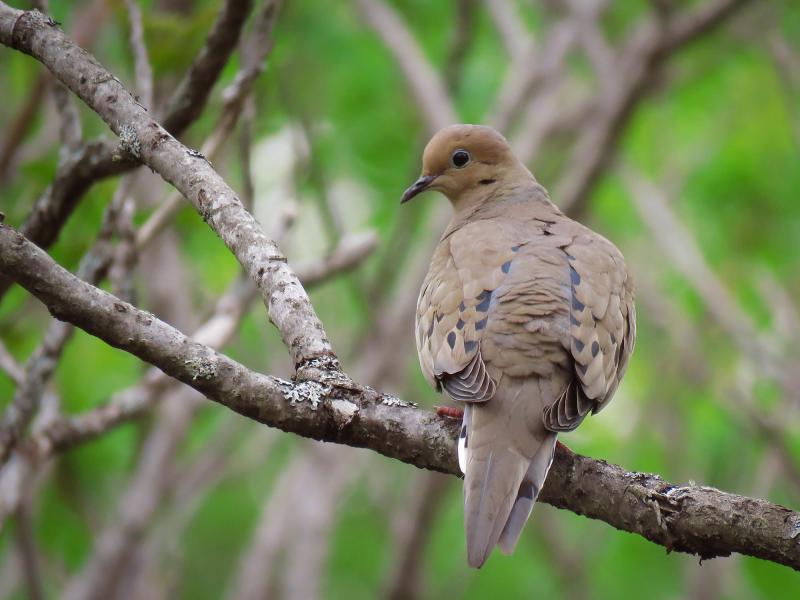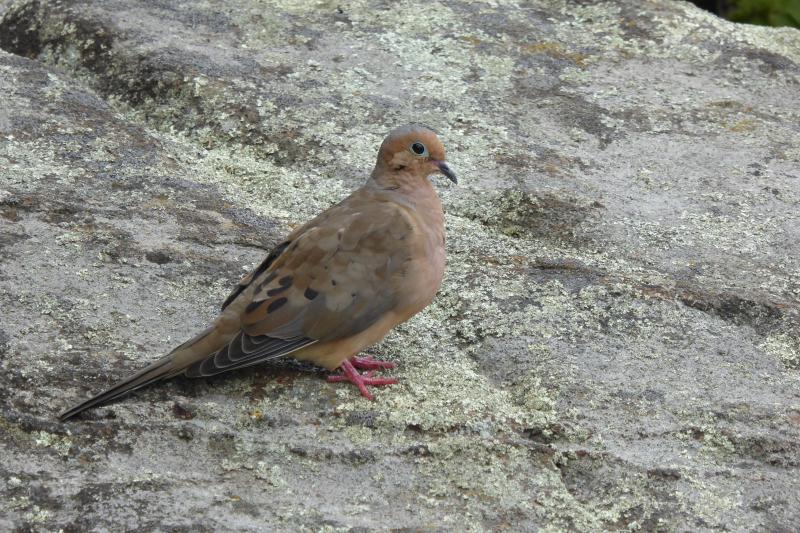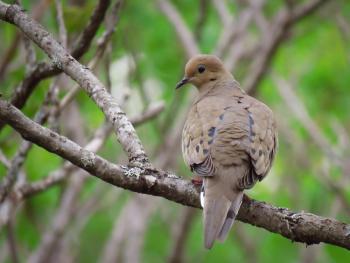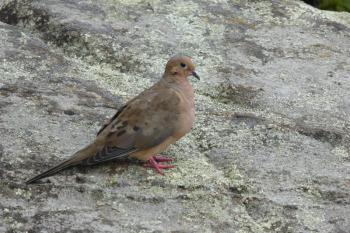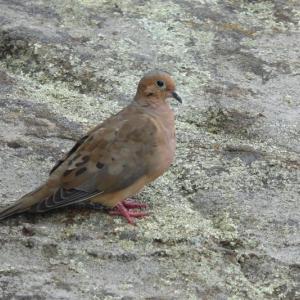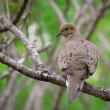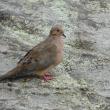Kristen Lindquist: Consider the Mourning Dove
It’s a chilly winter dusk as the last mauve shades of sunset fade from the sky. Overhead, a pair of birds flits quickly past, headed together to roost, a poignant sight in the dying light. From their long-tailed profiles and the whistling of their wings, I recognize them as Mourning Doves. It feels appropriate to see birds with such a name as the day passes away.
The Mourning Dove’s name doesn’t come from its penchant for inspiring such nostalgic pathos at the end of the day, however, but for the sad, sighing coos of its call. These mournful notes often play gently in the background behind the more blatant songs of our other backyard birds, the loudly vociferous cardinals, wrens, and titmice.
And truly the bird itself is not one to seek the limelight with its voice or its appearance. The humble dove is easily overshadowed by the lipstick-red male cardinal or brash Blue Jay. Even the muted yellows of a winter goldfinch stand out better against the snow. But the dove’s understated plumage is beautiful when observed closely: soft, warm brown overall with a faint rosy tint, delicate black spotting, a black beauty mark on its face, and some white at the tail edges most obvious when it flies. With binoculars you might notice its pink feet and a thin blue ring like eyeshadow around its dark eye. The sexes look alike, for all practical purposes, so both male and female are decidedly un-flashy.
The dove’s small head and sleek body with long, pointed tail give it an appearance of dainty composure. They look like pert little hens as they roam my yard pecking for seeds, unafraid of my presence. Usually in mated pairs, or small groups in the winter, they’re quick to fly up when startled, but they don’t go far. They’re among my cherished “regulars,” even through the winter.
Mourning Doves are so common, and so ubiquitous throughout the year here in coastal Maine, that it might come as a surprise that that wasn’t always the case. This species was in the vanguard of southerners, including such songbirds as Northern Cardinal, Tufted Titmouse, and Carolina Wren, that have slowly expanded their ranges into northern New England over the past several decades—thanks in part to both bird feeders and climate change, as well as a little pioneering bird spirit.
Early Maine bird books bear out this trend. Only 80 years ago, “Birds of Mt. Desert Island, Acadia National Park, Maine,” a little booklet co-authored by Carroll Tyson and James Bond (the ornithologist for whom the fictional spy was named!) cites them as “rare” on that island.
Ralph Palmer’s classic Maine Birds, published in 1949, reports that the first Maine nest was discovered in Eliot in 1919. And, interestingly, “the most easterly records are for three birds in 1944-45 at Topsham and for winter occurrence since 1945 at Swan Island, Richmond.” So the bird hadn’t even made it to Knox County yet at that point, although Palmer concludes his section on the Mourning Dove by asserting, “The population continues to increase slowly, and the bird is extending its breeding range in the state.”
Moving up a few years and a little closer to home, Frederick V. Hebard’s The Land Birds of Penobscot Bay (1960) cites the Mourning Dove as a “summer resident” in the Camden-Rockland area during the mid-1950s. He also highlights the Mourning Dove as a species one might find birdwatching along Camden’s Bay View Street to Seaview Cemetery.
In the 1972 edition of the Maine Audubon Society’s publication Enjoying Maine Birds, the Mourning Dove continues as a summer resident that’s still “rare in the northern and eastern portions of the state.” But also, “a few spend the winter in southern counties” by then. Peter Vickery’s “Annotated Checklist of Maine Birds” (1978) shows the Mourning Dove as “common to abundant” from mid-March to mid-November, and merely “uncommon” for the rest of the year.
Eighteen years later, in Vickery’s A Birder’s Guide to Maine (co-written by Liz and Jan Pierson), a thick, black line on the checklist has solidified the Mourning Dove’s position as “common to abundant” year-round throughout the state. There are so many around today, we don’t even think about them, really, don’t stop to marvel at their presence. But a close observer might notice that Mourning Doves in Maine often sport disfigured toes: this relative newcomer from the south remains susceptible to frostbite. Its maladapted toes give away its provenance.
According to US Fish & Wildlife, the Mourning Dove is “one of the most widely distributed and abundant birds in North America.” It is found in every state and hunted as a game bird in 42 of them, not including Maine. (Rhode Island is the only New England state that allows hunting of Mourning Doves.) Yet even with 20 million birds harvested annually, the U.S. population is estimated at around 350 million birds. Far from being a bird to worry about, it seems to thrive around people, hanging out at our bird feeders and nesting sometimes very near our homes (in a porch flowerpot or an old Christmas wreath, say).
Maybe the abundance of the Mourning Dove is something we can come to appreciate about this low-key bird. In light of the recent report that North American bird numbers have declined by three billion in the past five decades, we can take some small consolation that during those fifty years, Mourning Doves became firmly rooted as a year-round species here in Maine. What was once a rare visitor we now take for granted.
But as we turn a new page of the calendar, perhaps we can also turn over a new leaf, to a new way of thinking. Let’s resolve to pay more attention to what we normally overlook: those quieter things around us that aren’t filling anyone’s Instagram feed but are nonetheless landing on our bird feeders. The brown birds, the birds in the background. Let’s consider the Mourning Dove and marvel that this subtle bird with the soft coo is here at all right now, freezing its toes off maybe, yet surviving the winter right along with the rest of us.
Kristen Lindquist is an amateur naturalist and published poet who lives in her hometown of Camden.
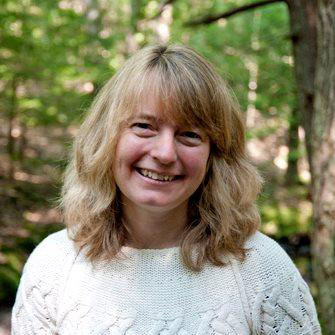
Event Date
Address
United States

